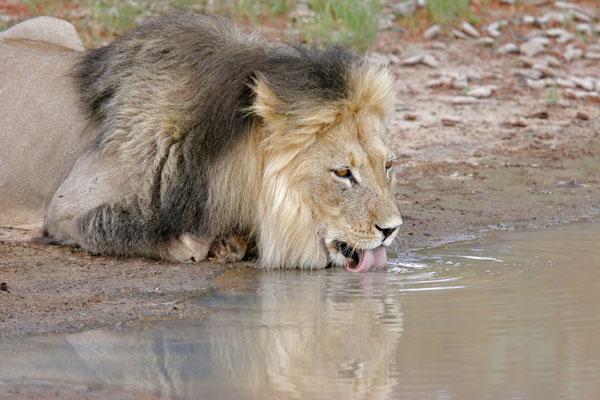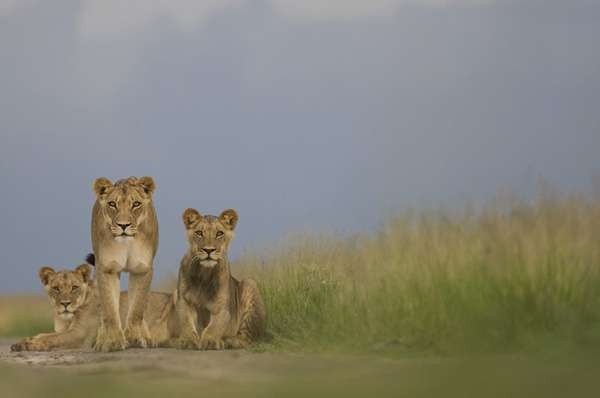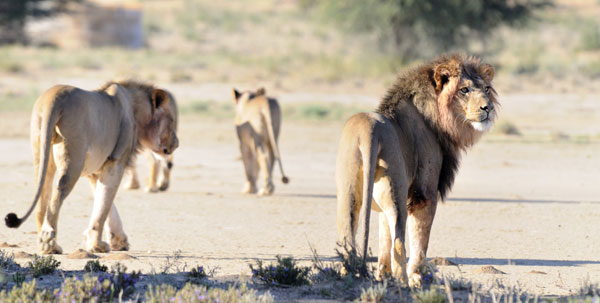It is a well-known fact amongst lion fans, field rangers & lion behaviourists, that these creatures are fiercely territorial and that they rely on the rigid social structure of their prides. Males patrol invisible boundaries, father the cubs, discipline the unruly, and represent the image of what is widely recognised as the icon of strength, power and bravery. The graceful, golden lionesses make up the majority of the pride; mothering the future leaders and bringing down the prey that will feed the pride and sustain its strength. This social structure is set in stone and without much variation, this is how lion prides have been dominating the animal kingdom since the beginning of time. This is an introduction to the lions of the Kalahari.
Lions occur throughout Africa, exuding prowess and eliciting fear and admiration from their subordinates. These great beasts command the very top of the food chain, with the only real threat being that of a human hunter. In a world of respect, the magnificent lion is widely idolised as the pinnacle of power and is depicted in all its glory as the majestic, maned King of the Jungle. As Africa’s terrain transforms from South Africa to Namibia and Botswana, Angola and Zambia, the existence of certain species and, indeed, the adaptation techniques of these species, can be correlated with the varying climates, vegetations, and landscapes. The fight for survival is the sole motivator for the existence of the majority of Africa’s animals; whether it is the survival of a pride, or the sole strength of a lone ranger; a herd of identical herbivores, or a matriarchy of predating meat-eaters. Africa’s wildlife is trained to survive trying circumstances and to persist until the very end. The lions of the Kalahari Desert have become a popular interest and in researching the behaviour of this specific group, it has become clear that they are well defined from their relatives residing in more “moderate” environments, such as the safe havens of South African Game Reserves. This notion is not intended to undermine the undeniable harshness of the wild worlds that exist within these protected borders, it is merely intended to emphasise the utter austerity of life in the world’s biggest desert.

The greatest continuous expanse of sand that exists is home to a large number of species, specially adapted to resist death under a scorching sun, on a surface of the earth that reaches seventy degrees Celsius, and in droughts that suck the last sip of water from the land. This unkind environment is alive with animal activity; much of it vibrating beneath the surface in an astonishing network of tunnels and holes – a habitat adopted by reptiles, insects, mammals and invertebrates. Many symbiotic relationships exist in the desert, as there is high competition for vital resources, like food, water and shelter. Cape cobras occupy mouse holes after devouring the original resident; goshawks build their homes safely atop giant, sturdy sociable weaver nests; jackals maintain close proximity to a hunting honey badger, awaiting any escapees that may bypass the badger’s gnashers. The inhabitants of the Kalahari practice exceptional life skills, enduring suffocating heat and spells of drought that crack the surface of the salt pans.
The lions, despite their status, are no exception to this punitive lifestyle. What set the kings apart from meager members of their kingdom are their lack of enemies and the non-existence of competition. As long as lions have a place in the pride, they are protected and they will eat, until injury or age takes their strength and they are unable to keep up with the pride. The same principal applies to the black-maned Dune Kings; however, the dynamics of the prides in this desert environment is what makes them unusually fascinating, placing them in a league of their own.
Physically distinguishable from their cousins in other areas of Africa, the lions of the great thirst land have fine fur of pale gold, longer, leaner legs and large feet; characteristics shared with other species adapted to desert living. Males flaunt manes ranging from glossy blonde to a dark, striking black, for which these lions are known. Females have ultra lean physiques, strong and stealthy, designed for endurance. These lions have innate cooling mechanisms that initiate the cooling of their blood before it reaches the brain. They protect themselves against the heat and the enormous stretches of aridity with a determined resistance to thirst. In order to maintain their strength, the Kalahari lions rely on frequent, small meals and have been known to prey on anything from common birds to enormous eland. An undeniable favourite is the porcupine; perceptibly a strange choice, as it is covered in harmful quills and course bristles and has a confrontational defense mechanism, which involves reversing its sharp rear into the face of its predator, often leaving septic wounds and disabling the hunter.

The Dune Kings defy the Rule of Lion in their observed tendency to scavenge and to cannibalise. The severity of the living conditions in the Kalahari leaves no option but every option. These lions face impossible odds, yet survival maintains its rank as number one priority, creating a pride dynamic and a social structure, indeed a physical stature, different to that of any other population of lion.
So intriguing is this wild existence that lion enthusiast, Fritz Eloff, spent a period of twenty six years observing a certain group of lions in the Kalahari, analysing and recording the astonishing nature of these untamed beasts. Identifying individuals, witnessing devastation and triumph, experiencing deathly darkness and blinding sunlight, and creating an unexpected bond with these animals; Fritz Eloff has penned the legacy of six particular legends of the Kalahari. In a forthcoming string of articles, the Dune Kings series will tell of the majesty of four renowned individuals and two extraordinary alliances that roamed the Kalahari between 1970 and 1995. Keep an eye out for the second entry in this series, which will introduce “Kromvoet of Gharagab”, a golden-maned, aggressive alpha male, and the first Kalahari King to catch Eloff’s attention.


